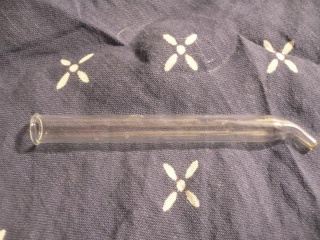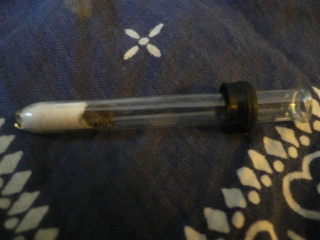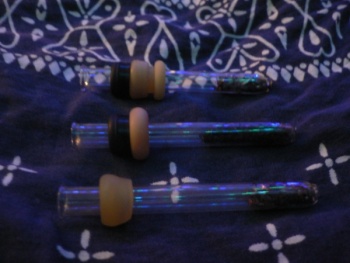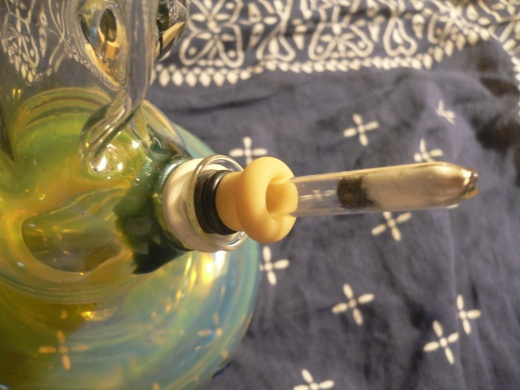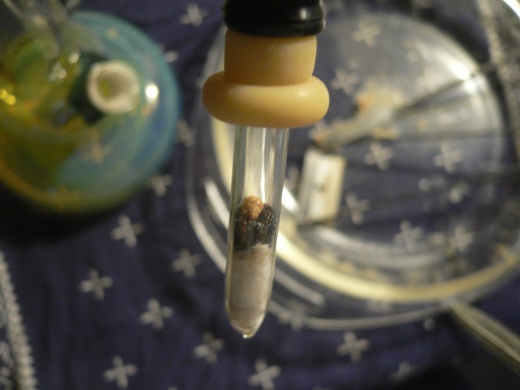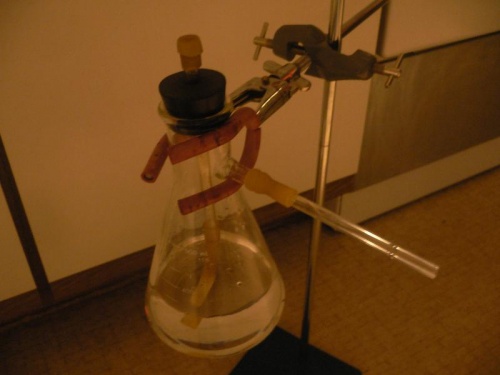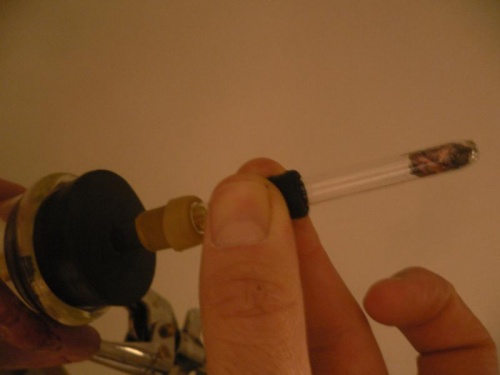The Inspirator
| Note: | This page tracks the development of The Inspirator[1]. The content is to remain accurate as such. |
|
in·spi·ra·tor (ĭn'spə-rā'tər) n.
[From Late Latin, from inspirare 'to inspire' (from in- + spirare 'to breathe') + -tor; cognate with, and possibly derived via, English or German] |
|---|
The advantage of The Machine is that having a copper or steel mesh between the product and the flame protects the product from direct contact with the flame as well as distributing the heat of the flame evenly and rapidly to the product. However, most have a difficult time constructing one in the recommended fashion. Also, many prefer to cool their vapor by bubbling it through water during administration, and a properly fashioned "machine" does not easily facilitate this. Yet another issue that plagues the machine is that metal mesh--while fairly efficient in distributing heat and protecting the product from the flame--could still stand some improvement.
The progenitor of the device featured in this tek, known as amor_fati's Mini-Machine Bubbler Stem sought to overcome many of the obstacles in use of "the machine," while operating essentially in much the same manner. Once mastered, the bubbler stem could be an incredibly effective vaporizer with only a few limitations: Some amount of product would run away from the plug and partway down the stem when used at the most natural angle for a bubbler bowl; though this could be overcome by a simple angle adjustment, or the product easily retrieved for successive hits by simply plunging the plug up the stem and back into place, its effectiveness and ease of use was greatly limited by this and the slight inefficiency of the metal mesh in providing even distribution of heat.
Probably the most universal cause of any degree of inefficiency for any variation of "the machine" is the direct heating of the metal mesh, given the mesh's poor capacity as a heat sink. This is evidenced in part by the amount of heat transfer from the plug to the glass, and the runoff that occurs in the mini-machine bubbler stem is likely, in part, due to that and how slowly and unevenly the mesh transfers heat. And so, to remedy this, a much better heat-sink was chosen to absorb the heat of the flame: Ceramic fiber is a material able to handle temperatures much higher than those generated by consumer butane torches and has a somewhat malleable structure, allowing it to be used in much the same way as metal mesh has been traditionally implemented. It's limitations are that it heats too rapidly to act as a stand-alone plug in "the machine," that it's soft and light and difficult to keep in position, and it doesn't easily allow good airflow. However, the addition of a shorter plug of metal mesh to act as a screen between the product and the ceramic helps to keep the ceramic fiber locked in position, protect the product from overheating, allows the fiber to be worked around in order to maximize airflow, and maintains ceramic fiber's advantage of not allowing any runoff.
A bubbler stem such as the one presented here and in this device's progenitor, is perhaps the most effective manner of putting ceramic fiber into practice, as it's size accounts for the potential for compromise of the fiber's structure. While the fiber can break quite easily, it remains just fluffy enough to remain intact in a device the size of a dropper and remains consistently in place when locked between the curvature of the glass and the mesh plug.
The Inspirator is considered by its creator to be the criterion of efficiency for vaporizing spice.
Contents
Procedure for Construction
- Carefully crush the nozzle of the dropper stem with pliers, leaving a slight portion of the nozzle's curve.
- Melt the broken end of the stem with a torch so that the sharp edges are dulled and any cracks sealed.
- Cut a segment of ceramic fiber, and use a thin metal rod to stuff it down toward the nozzle-end somewhat snuggly, and so that a part of the ceramic is exposed out of the broken end.
- Cut off a minimal piece of the metal scrub pad, hold it with pliers, and burn with a torch under an oven hood until no more smoke is emitted.
- After it has cooled, stuff it in the larger end of the dropper stem and down toward the ceramic to lock it in place.
- Fit two gaskets on the stem far enough from the plug to avoid heat but far enough from the other end to provide a stable stem.
- alternatively and more cheaply, a small section of latex tubing could be rolled or folded into a ring around the stem to serve the same purpose.
- Use a safety pin to punch 1-3 holes all the way through the middle of the ceramic/copper plug, while holding the plug condensed and in place, to ensure adequate airflow.
- there should be some amount of pressure but no strain on the draw.
- airflow is the key factor in ensuring the quality and effectiveness of the device.
Administration.
- Place product into the open end of the stem and stuff down to the plug with a thin metal rod.
- Feather the glass with a torch until the product melts into the mesh plug.
- Insert the stem into a bubbler as a bowl, with the open end in.
- Use a torch to apply heat to the exposed ceramic portion of the plug while drawing air through the bubbler.
- keeping some distance with the torch is recommended to avoiding burning or overheating.
- Only apply heat until a decent amount of vapor can be observed in the chamber, carb the bubbler immediately but briefly, and continue to apply heat and inhale in the same manner.
- once the device reaches a sufficient temperature, it will give off vapor rapidly and will not necessarily require continued heat application, but continue to heat periodically during the draw to ensure complete vaporization.
| Use with an Improvised Labware Bubbler | ||||||
|---|---|---|---|---|---|---|
|
Notes on Effective Use and Maintenance
- A handy method for storing the piece would be to cap the nozzle end with the dropper bulb in order to protect from breakage and keep track of the bulb to use when cleaning.
- The second gasket generally makes the piece safer to handle--especially if used as a pull stem--while the other provides a seal.
- For group sessions, it would be easiest to prepare an individual piece for each person so that dosage can be more easily regulated.
- When handling the piece after heating, handle by the gasket and avoid any part of the heated portion of the glass coming into any contact with hard surfaces.
- A good way to cool down a stem is to roll it rapidly between the palms, drawing the heat off the glass with one's hands.
- If the the nozzle end of the piece breaks off at any point, carefully push the plug to the other end of the piece when it has sufficiently cooled, heat the sharp edges until dulled, and push the plug back into place firmly, with a finger in place causing the plug to mushroom slightly until it fits snugly in place.
- Ensure adequate airflow through the piece by poking holes in the plug with a safety pin.
- Develop a relationship with the device.
Appendices
- Special Thanks:
- To Warrensaged for pioneering the use of a machine-style bowl with a bubbler.
- To q21q21 and Bumber for inspiring the development of this method.
